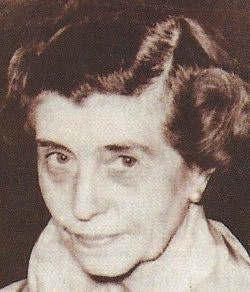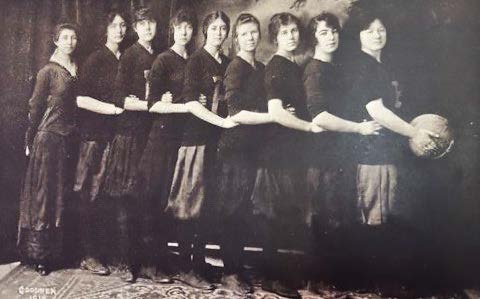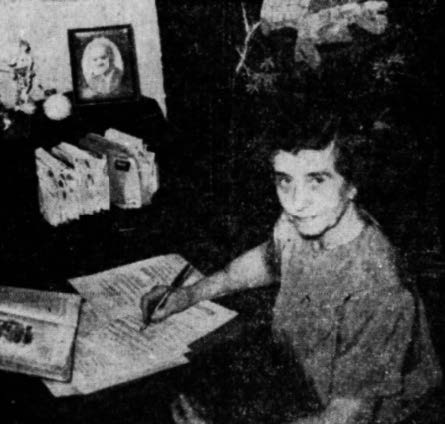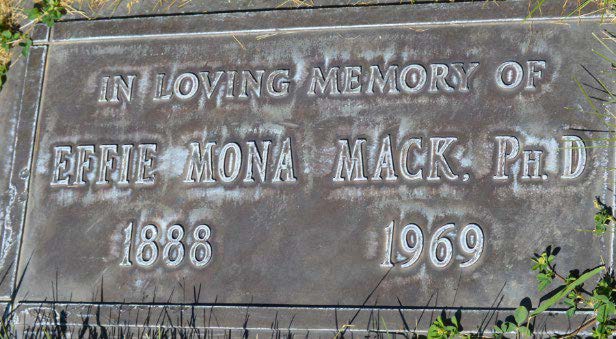The information below has been compiled from a variety of sources. If the reader has access to information that can be documented and that will correct or add to this woman’s biographical information, please contact the Nevada Women’s History Project.

Reno Evening Gazette, 1947
At a Glance:
Born: Oct. 25, 1888, Seneca, Kansas
Death: Feb. 1, 1969, Reno, Nevada
Race/nationality/ethnic background: Caucasian
Married: no
Children: no
Primary City and County of Residence and Work:
Reno, Washoe County, and Las Vegas, Clark County
Major Field of Work: Nevada history, education
Reno High teacher wrote volumes on Nevada history
A prolific writer, historian, and beloved teacher, the woman whose name graces the University of Nevada’s Social Sciences Building also coached the Reno High School girls’ basketball team to two state championships. The victories happened during Effie Mona Mack’s first five years at the high school where she was a teacher in the history and political science department for 40 years, from 1914-1954. But as much as she enjoyed her coaching stint, her real passion was learning, teaching, and writing about the history of her adopted state.

Born in Seneca, Kansas, on October 25, 1888, Mack was the daughter of Emeline and Orel Henry Mack. When she was 12, the family, which included her brother and two sisters, moved to Reno. After graduating from Reno High School, she received her first degree, a Bachelor of Arts, from the University of Nevada, Reno. She traveled to the mining boom town of Manhattan, about 50 miles north of Tonopah, where she served as teacher and principal of the Manhattan School for a year. She returned for a brief stay in Reno, where a local society columnist called her “one of Reno’s most popular girls, who will be exceedingly missed” before she traveled east to Smith College in Massachusetts, where she received her second Bachelor of Arts degree, this one in history, in 1912. She returned to the University of Nevada for more classes, before going to the west-central Nevada railroad town of Mina for one year of teaching.
In 1914, Effie Mack started teaching history at her Reno high school alma mater. While teaching, she continued her studies at UNR until she got her Master of Arts degree in History, in 1916. She often traveled during her summers to Berkeley, to attend University of California summer courses and to visit her brother Leonard. She received her Ph.D. from University of California, Berkeley in 1930. During her college years, she was a member of Kappa Alpha Theta sorority, a tie she maintained for many years thereafter and in 1929, she was inducted into Sigma Kappa Alpha, a history honor society.
Mack started publishing historical works in the 1930s. Her first was the dissertation for her doctorate from the University of California, at the time the only doctorate awarded for Nevada history. The work was called William Morris Stewart, Empire Builder, 1827-1909, about the influential, and often controversial, gold miner turned politician in both California and Nevada. She published many Nevada history texts, the first called History of Nevada – Through the Civil War, which was published in 1935. Another, called Nevada: A History of the State from Earliest Times Through The Civil War came out a year later. Together with Byrd Wall Sawyer, she authored Our State: Nevada in 1940, which was required reading for seventh and eighth graders.

Samuel Clemens was her subject in 1947, with the publication of Mark Twain in Nevada, which took second place in the 100th anniversary contest of Scribner’s Magazine. It describes Clemens’ evolution from, as the Reno Evening Gazette put it, “a brash young man who came to this state on a carpetbagger’s train into Mark Twain, a writer and humorist of national repute.” She described her extensive research for her book, saying she had traveled every footstep Twain had traveled, multiple times, except for the 40-Mile Desert, when she could find no one willing to walk it with her. Like Twain, she was, for a time, the editor of the Virginia City Times, 1958-1961.
In 1953, she and Idel Anderson and Beulah E. Singleton, two other Reno High School history teachers, wrote Nevada Government, a Study of the Administration and Politics of State, County, Township, and Cities, at the time a much-needed secondary social studies text. Going in a very different direction, she took the nom de plume Zeke Daniels to write about renowned Virginia City prostitute Julia Bulette in the book The Life and Death of Julia Bulette: “Queen of the Red Lights” in 1958, with Ben Christy. 1961 saw the publication of two more books, Here is Nevada: a History of the State, co-authored with Byrd Wall Sawyer, as well as Territorial Centennial of Nevada, 1861-1864. Mack reached back to her doctoral interest in William Stewart, with the publication of William Morris Stewart, 1827-1909, in 1964. The Indian Massacre of 1911 at Little High Rock Canyon, Nevada came out in 1968.
Despite her growing renown as a Nevada history expert, Mack came up against the Reno school system’s mandatory retirement age of 65 in 1954. She requested that the school board extend her contract into 1955, but after a contentious board meeting, only one trustee voted to retain her. It was felt that making an exception for her would split the district’s 260 teachers into opposing factions. Mack made the most of the situation, however, traveling south to be part of the first faculty at the University of Nevada at Las Vegas, teaching history and political science there for two years.
Mack lived much of her life with her mother, well known suffragist Sarah Emeline Mack, who died in 1947. In 1950, Effie donated her mother’s extensive collection of historical papers to the Nevada Historical Society. It is known as the “Sarah Emeline Mack papers, 1911-1946,” and documents much of Nevada women’s history during the first half of the 20th century.
Possibly Effie Mona Mack’s greatest legacy was the efforts she made to keep the journals of noted Nevada journalist Alf Doten in the state. She had seen that other memorabilia of Nevada had been purchased and left the state and heard that Doten’s diaries were coming up for sale. Doten wrote 79 volumes of personal memoirs, including when he came to California in 1849 through his death in 1903. They provided fascinating insights into his daily life and had been in the possession of his family. They were sold to the John Howell Company, a dealer of Western Americana in San Francisco. In 1961, they were again put up for sale, this time for $50,000. Effie Mona lobbied the Nevada Legislature to appropriate $20,000, and UNR raised the remaining funds through a Max C. Fleischman Foundation grant. Walter Van Tilberg transcribed the journals into a three-volume book called The Journals of Alf Doten, 1849-1903, published in 1973 and since digitalized and now available online.
In addition to her scholarly work, Effie Mona Mack was very busy with Reno organizations. She was active in Red Cross work and Liberty Bond drives, and could be seen serving food to soldiers at the Reno railroad depot during World War I. She was a charter member and organizer of the Reno branch of the American Association of University Women. Mack was awarded life membership in the Oregon Trail Memorial Association in 1937. She served as a member of the Advisory Committee for Nevada women’s participation in the New York World Fair in 1939. She was a charter member of the Reno unit of American Women’s Voluntary Service, and she participated in discussions on the writing of the United Nations Charter in San Francisco in 1945. She helped organize Genoa’s celebration of the 110th anniversary of its founding and Virginia City’s celebration of the 100th anniversary of the first significant discovery of silver in the United States.
In 1950, she arranged a five-month course for teachers on “Education for the Atomic Age,” one of the first teacher development classes in the nation to look at atomic energy. She was named Reno Woman of the Month by local clothier Joseph Magnin. She represented social studies teachers of Nevada at the Industrial Council sponsored by Rensselaer Polytechnic Institute in Troy, N.Y. in 1953. She was a member of Trinity Episcopal Church, the American Historical Association and the Sagebrush chapter of the Daughters of the American Revolution, as well as the National Civil War Advisory Council, the Lake Tahoe Area Council and the Reno Executives Club. She served on the Washoe County platform committee of the Republican Party. She was one of the first members of the American Association of Retired Teachers. She was a member and historian of the Nevada Commemorative Stamp Committee.
In her “spare time,” she even was a businesswoman, running the Seven Seas Gift Shop in Reno’s Riverside Hotel from 1933 until 1950. She also used her extensive knowledge of history and antiques to serve as an appraiser of large estates.
In 1952, when there was a movement to change the name of Slide Mountain to Mount Reno, to better the city’s name recognition, she wrote in the local paper a strong historical defense of the Slide moniker, saying it didn’t need more recognition, as it was immortalized by Mark Twain in his book Roughing It.
Her research extended to every institution and county in Nevada, as well as many in California and in the Library of Congress. Her writing appeared in periodicals, too. She wrote a Nevada State Journal column called “Comstock Profiles” and wrote articles for Nevada Magazine. She was often a contributor to the American Dictionary of History.
Her passionate devotion to preserving Nevada’s heritage ended on February 1, 1969, at Washoe Medical Center, when Effie Mona Mack passed away at the age of 80. She is buried in the Masonic Memorial Garden at Mountain View Cemetery in Reno.

Major Writings by Effie Mona Mack
- 1930 William Morris Stewart, Empire Builder, 1827-1909
- 1936 Nevada: A History of the State from Earliest Times Through The Civil War
- 1940 Our State: Nevada, with co-author Byrd Wall Sawyer
- 1947 Mark Twain in Nevada
- 1953 Nevada Government, a Study of the Administration and Politics of State, County, Township, and Cities, with co-authors Idel Anderson and Beulah E. Singleton
- 1958 The Life and Death of Julia Bulette: “Queen of the Red Lights” in 1958, with co-author Ben Christy
- 1961 Here is Nevada: a History of the State, with co-author Byrd Wall Sawyer
- 1961 Territorial Centennial of Nevada, 1861-1864
- 1964 William Morris Stewart, 1827-1909
- 1968 The Indian Massacre of 1911 at Little High Rock Canyon, Nevada
Researched by Patti Bernard and written by Kitty Falcone. Posted 10/10/2024.
Bibliography
- “Author to be Honored.” Reno Evening Gazette (Reno, Nevada), 16 Sept 1947, p. 15:2.
- “Book on Nevada Government Written by 3 Reno Teachers Being Published This Month.” Nevada State Journal (Reno, Nevada), 11 January 1953, p. 2:5.
- “Dr. Effie Mack Chosen to Write History.” Nevada State Journal (Reno, Nevada), 8 April 1937, p. 2:1.
- “Dr. Effie Mack Granted Leave.” Nevada State Journal (Reno, Nevada), 21 August 1955, p. 28:2.
- “Dr. Effie Mack Honored For Historical Works.” Reno Evening Gazette (Reno, Nevada), 5 February 1966, p. 18:4.
- “Dr. Mack’s Gifts to Scholars.” Reno Evening Gazette (Reno, Nevada), 13 February 1969, p. 17:3.
- Find a Grave, database and images
- (https://www.findagrave.com/memorial/165917036/effie-mona-mack: accessed 24 April 2019). Memorial page for Dr. Effie Mona Mack (1888-1969), Find a Grave memorial no. 165917036, citing Masonic Memorial Gardens, Reno, Washoe County, Nevada, USA.
- “History of Nevada Written For Use in Schools of State by Dr. Mack and Mrs. Sawyer.” Reno Evening Gazette (Reno, Nevada), 1 May 1940, p. 3:1.
- Kuser, Dryden. “The Why of Taxes.” Nevada State Journal (Reno, Nevada), 31 May 1947, p. 7:6.
- “Life of Senator Stewart Is Compiled by Instructor In History at Reno School.” Reno Evening Gazette (Reno, Nevada), 23 April 1930, p. 2:3.
- Mack, Effie Mona. “Recollects Documents On Boundary Dispute.” Reno Evening Gazette (Reno, Nevada), 23 February 1959, p. 3:1.
- “Miss Effie Mack has gone to Berkeley, Cal., to attend summer school.” Nevada State Journal (Reno, Nevada), 30 June 1918, sec. In the Realm of Society, p. 7:5.
- “New Book Published on Nevada History.” Nevada State Journal (Reno, Nevada), 23 November 1965, p. 23:2.
- “Newest History of Nevada Placed on Sale Here Today; Written by Dr. Effie Mack.” Reno Evening Gazette, 22 October 1935, p. 8:1.
- “Post in Vegas for Historian.” Reno Evening Gazette (Reno, Nevada), 29 July 1954, p. 15:6.f.
- “R. H. S. Girls’ Team Will Go To Dayton.” Nevada State Journal (Reno, Nevada), 5 November 1915, p. 8:6.
- “Reno Historian, Teacher, Writer Dies at 80.” Reno Evening Gazette (Reno, Nevada), 1 February 1969, p. 1:7.
- “Reno Teachers Take Training For Atomic Age.” Reno Evening Gazette, 17 February 1950, p. 17:1.
- “Miss Effie Mack who has been principal of Manhattan school this term, will return home.” Reno Evening Gazette (Reno, Nevada), 17 April 1910, sec. Society’s Doings in Reno. p. 8:2.
- “Twain In Nevada Told In New Book.” Reno Evening Gazette (Reno, Nevada), 24 May 1947, p. 5:1.
- “University Presents Gay Scene in Honor of Departing Graduates.” Nevada State Journal (Reno, Nevada), 18 May 1916, p. 2:2.
- “Veteran Teacher Retired From School System.” Reno Evening Gazette (Reno, Nevada), 28 April 1954, p. 13:6.
- White, Claytee and Su Kim Chung. “Dr. Effie Mona Mack – Pioneering Nevada Historian, Educator, and Author.” The Women Who Saved History, Episode 3, Women of Diversity, Inc., 26 May 2024, https://thewomenwhosavedhistory.buzzsprout.com/2345493/episodes/15109414-dr-effie-mona-mack-pioneering-nevada-historian-educator-and-author
- Year: 1900; Census Place: Seneca, Nemaha, Kansas, Page: 16; Enumeration District: 0125; FHL microfilm: 1240492.
- Year: 1910; Census Place: Reno Ward 1, Washoe, Nevada; Roll: T624_859; Page: 8A; Enumeration District: 0068; FHL microfilm: 1374872.

